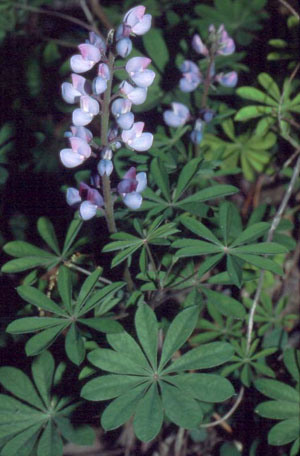
Sundial Lupine (Lupinus perennis)
Photograph by Richard H. Wiegand
Q. What to do when an endangered animal is eating an endangered plant?
A. Don't interfere!
In many cases, the lack of host plants may be the reason for rarity in butterflies.
The Sundial Lupine, considered State Threatened, likes to bask in the open sunny areas of dry woodland glades, savannas, grasslands, and roadsides. This is where you will find the globally rareFrosted Elfin. Sundail Lupine is the primary larval host plant of this gossamer-winged butterfly in Maryland (a secondary host is the Blue False Indigo, (Baptisia australis). More and more, these species are being restricted to powerline rights of way and declining disturbed areas.
The Frosted Elfin in Maryland performs its adult flight in April and May. It lays its eggs singly on the leaves of the Wild Lupine. Caterpillars hatch out a few weeks later and feast upon the flowers and fruits of the lupine. Each caterpillar then burrows into the duff and soil and pupates, or forms a chrysalis (a hard-shelled cocoon). The pupa will stay in this crysalid stage for the rest of the year, overwintering in the soil. In this pupal stage, the bodies of the caterpillars break down and reform as adults, ready to break out in the spring and continue their life cycle. Adult Frosted Elfins, not strong fliers, don't stray too far from their host plant.
The perennial Sundail Lupine opens its blue (and sometimes pink or white) flowers in May and June. It can grow 7 to 24 inches tall and produce flattened seed pods, much like a hairy pea (they are in the same family, the Legumes). It may be found statewide but tends to be in scattered populations. Its preferred habitat is on the decline.
Threats to the butterfly are the same as the threats to its host plant.
The loss of habitat to development and succession (the natural tendency of habitats to change from one state to another, i.e. grassland to shrubland or forest) are the primary reasons. Development may be influenced by zoning laws and by encouraging holistic thinking during the planning process:
-
How much land do we truly need?
-
Can we reduce the footprint?
-
Can we share facilities and amenities (sewer, parking, greenspace) to reduce the impact on the landscape?
-
Can we use technologies, such as Green Building techniques, that provide benefits to the landscape.
Succession is also a matter of vegetation management. If we wish to maintain populations of species which depend upon a certain habitat, we need to ensure the existence of that habitat. Grasslands and savannas may be maintained by mowing or prescribed burns, but the timing of these techniques must not interfere with the species' reproduction. Lupine populations which grow at roadsides may be damaged if the roadside is mowed during May through July, its peak flowering and fruiting time.
One additional threat to the Frosted Elfin is pesticide use in combating gypsy moth infestations. This is especially important for those elfin populations adjacent to forested areas. Time of spraying and consideration of alternative methods for gypsy moth control are useful tools in handling this issue.
Much of what the Maryland Natural Heritage Program does is geared toward studying and protecting habitats which support rare plants and animals which contribute to the biological diversity of Maryland.
